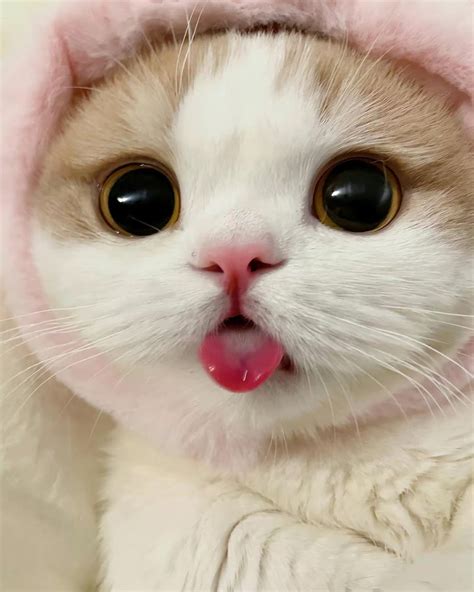
A tuxedo cat named Oreo has captivated the internet with a heartwarming ritual of greeting his owner, Ben, with an enthusiastic “toddler-like” welcome, showcasing a display of feline affection that resonates with pet lovers worldwide.
A video of Oreo’s daily greeting, posted on Reddit by Ben under the username u/uaitforeo, shows the cat excitedly chirping and meowing while standing on his hind legs to reach for his returning owner. The video, which has garnered significant attention, perfectly captures the bond between Oreo and Ben, highlighting the unconditional love pets offer their owners. According to Ben, this behavior has been a consistent part of their routine for years, characterizing Oreo’s unique personality and deep affection. The viral clip has drawn thousands of comments and shares, with viewers expressing their admiration for Oreo’s charming greeting and the evident connection he shares with his human companion.
Oreo’s Unique Greeting Ritual
Oreo’s greeting is far from the typical feline indifference often associated with cats. Instead, he exhibits a level of enthusiasm more commonly seen in dogs. Upon hearing Ben’s arrival, Oreo immediately rushes to the door, standing on his hind legs in anticipation. As Ben enters, Oreo extends his paws, reaching up as if asking for a hug, all while emitting a series of chirps and meows that Ben interprets as a joyful welcome.
“He’s always done this since he was a kitten,” Ben explained in an interview. “It’s his way of showing he missed me, I guess.”
The behavior, which Ben affectionately refers to as Oreo’s “toddler greeting,” has become a cherished part of their daily routine. It’s a moment of pure, unadulterated joy that strengthens the bond between owner and pet, underscoring the emotional capacity of animals and their ability to form meaningful relationships with humans.
The Science Behind Feline Greetings
While Oreo’s greeting is exceptionally demonstrative, cats have various ways of showing affection towards their owners. These behaviors are often rooted in their evolutionary history and their understanding of social bonds.
-
Vocalization: Cats meow to communicate with humans, a behavior they typically don’t exhibit with other cats. The different types of meows can convey various needs or emotions, from hunger to a simple greeting. Oreo’s chirps and meows are likely his way of vocalizing his excitement and happiness at Ben’s return.
-
Rubbing: Cats have scent glands in their cheeks, flanks, and paws. When they rub against objects or people, they are depositing their scent, effectively marking them as part of their territory or social group. This behavior is a sign of comfort and familiarity.
-
Kneading: This behavior, often referred to as “making biscuits,” is a remnant of kittenhood. Kittens knead their mother’s belly to stimulate milk flow. When adult cats knead on soft surfaces or their owners, it’s a sign of contentment and relaxation.
-
Slow Blinking: This is often referred to as a “cat kiss.” When a cat slowly blinks at you, it means they are comfortable and trust you. It’s a non-threatening gesture that indicates affection.
-
Bringing Gifts: While not always appreciated, cats sometimes bring their owners “gifts” like dead animals. This behavior is thought to be a remnant of their hunting instincts and a way of providing for their social group.
The Power of the Human-Animal Bond
The overwhelming response to Oreo’s video highlights the powerful connection people have with their pets. Pets offer companionship, unconditional love, and emotional support, which can significantly improve their owners’ mental and physical well-being.
Studies have shown that owning a pet can lower blood pressure, reduce stress levels, and increase levels of dopamine and serotonin, neurotransmitters associated with pleasure and happiness. Pets can also combat loneliness and provide a sense of purpose, particularly for individuals who live alone or struggle with mental health issues.
Furthermore, the bond between humans and animals is mutually beneficial. Pets rely on their owners for food, shelter, and care, while owners receive companionship, affection, and emotional support in return. This symbiotic relationship enriches the lives of both humans and animals.
Tuxedo Cats: A Breed Apart?
While Oreo’s affectionate behavior is unique to his personality, tuxedo cats, like Oreo, have a certain charm and appeal that makes them popular pets. Tuxedo cats are not a specific breed but rather a color pattern found in various breeds, characterized by a black and white coat that resembles a tuxedo.
They are often perceived as intelligent, playful, and affectionate. While there is no scientific evidence to support the notion that tuxedo cats are inherently different from other cats in terms of personality, their striking appearance and playful antics often contribute to their popularity.
The combination of Oreo’s distinctive tuxedo pattern and his endearing “toddler greeting” has undoubtedly contributed to his viral fame. He embodies the charm and affection that many people associate with tuxedo cats, making him an ambassador for the breed.
The Internet’s Reaction
Oreo’s video has resonated with people from all walks of life, drawing thousands of comments and shares across various social media platforms. Many viewers have expressed their admiration for Oreo’s affectionate greeting and the strong bond he shares with Ben.
“This is the sweetest thing I’ve seen all day,” one Reddit user commented. “Oreo is clearly very loved and very loved.”
“My cat does something similar,” another user shared. “It’s the best feeling in the world to come home to that kind of excitement.”
The video has also sparked discussions about the emotional capacity of cats and the importance of the human-animal bond. Many people have shared stories of their own pets and the unique ways they show affection.
The outpouring of love and support for Oreo and Ben highlights the positive impact that pets can have on people’s lives and the power of the internet to connect people through shared experiences.
Caring for a Cat: Essential Tips
Inspired by Oreo’s heartwarming story, many people may consider adopting a cat. Caring for a cat requires a commitment of time, resources, and love. Here are some essential tips for providing a happy and healthy life for your feline companion:
-
Nutrition: Provide your cat with a high-quality cat food that meets their nutritional needs. Consult with your veterinarian to determine the best food for your cat’s age, breed, and activity level. Always provide fresh water.
-
Litter Box: Cats are naturally clean animals and require a clean litter box. Scoop the litter box daily and change the litter completely at least once a week. Place the litter box in a quiet, accessible location.
-
Scratching Post: Cats have a natural instinct to scratch. Provide your cat with a scratching post to protect your furniture and carpets.
-
Playtime: Cats need regular playtime to stay physically and mentally stimulated. Provide your cat with toys and engage in interactive play sessions.
-
Veterinary Care: Regular veterinary checkups are essential for maintaining your cat’s health. Schedule annual checkups and vaccinations. Be sure to also provide preventative care like flea, tick, and heartworm prevention.
-
Grooming: Regular grooming helps to keep your cat’s coat healthy and prevent mats. Brush your cat regularly, especially if they have long hair.
-
Love and Attention: Cats need love and attention just like any other pet. Spend time with your cat, pet them, and talk to them.
By providing your cat with proper care, you can ensure a long, happy, and healthy life together.
Conclusion
Oreo’s story is a heartwarming reminder of the unconditional love and joy that pets bring into our lives. His enthusiastic “toddler greeting” has captured the hearts of people around the world, underscoring the powerful bond between humans and animals. Whether it’s a playful chirp, a gentle rub, or an enthusiastic greeting, pets have unique ways of showing their affection and enriching our lives in countless ways. Oreo’s viral video serves as a celebration of the human-animal bond and a testament to the enduring power of love and companionship.
Frequently Asked Questions (FAQ)
- What breed is Oreo?
Oreo is not a specific breed but rather a tuxedo cat, which refers to the black and white color pattern of his fur. This pattern can occur in various cat breeds.
- How did Oreo’s greeting ritual start?
According to his owner, Ben, Oreo has been greeting him this way since he was a kitten. It’s become a consistent part of their routine and a way for Oreo to express his affection.
- Why do cats meow and chirp at humans?
Cats meow primarily to communicate with humans. The different types of meows can convey various needs or emotions. Chirping is often a sign of excitement or anticipation, as seen in Oreo’s greeting.
- What are the benefits of owning a cat?
Owning a cat can lower blood pressure, reduce stress levels, and increase levels of dopamine and serotonin, neurotransmitters associated with pleasure and happiness. Cats also provide companionship, unconditional love, and emotional support.
- How can I make my cat more affectionate?
Providing your cat with a comfortable and stimulating environment, engaging in regular playtime, offering plenty of affection, and respecting their boundaries can help strengthen your bond and encourage affectionate behavior. Positive reinforcement, like treats and praise, can also be effective.
- What is a “tuxedo cat”?
A tuxedo cat is not a breed, but a coat color pattern. It refers to cats, primarily black and white, that have markings that resemble a tuxedo, usually with a black body and white chest and paws.
- Is Oreo’s behavior normal for cats?
While not all cats exhibit such an enthusiastic greeting, cats have various ways of showing affection. Oreo’s behavior is unique to his personality, but it highlights the emotional capacity of cats to form strong bonds with their owners.
- What does it mean when a cat rubs against you?
When a cat rubs against you, it’s depositing its scent, effectively marking you as part of their territory or social group. This behavior is a sign of comfort, familiarity, and affection.
- How can I provide the best care for my cat?
Provide your cat with a high-quality diet, a clean litter box, a scratching post, regular playtime, veterinary care, grooming, and plenty of love and attention.
- How did Oreo’s video go viral?
Oreo’s video went viral due to his unique and heartwarming greeting ritual, which resonated with people from all walks of life. The video captured the strong bond between Oreo and his owner, showcasing the unconditional love that pets offer.
- What is the significance of the human-animal bond?
The human-animal bond is a mutually beneficial relationship that enriches the lives of both humans and animals. Pets provide companionship, affection, and emotional support, while owners provide food, shelter, and care.
- Does Oreo have any other unique behaviors?
While the article focuses on Oreo’s greeting ritual, his owner may have shared other unique behaviors on social media or in interviews that are not explicitly mentioned in the article. Additional research on Oreo’s social media presence could provide more insights.
- Are tuxedo cats known for being more affectionate?
There is no scientific evidence to support the notion that tuxedo cats are inherently more affectionate than other cats. However, their striking appearance and playful antics often contribute to their popularity as pets.
- How can I ensure my cat is happy and healthy?
Provide your cat with a stimulating environment, regular playtime, a healthy diet, regular veterinary checkups, and plenty of love and attention. Observe your cat’s behavior for any signs of illness or distress and seek veterinary care promptly.
- What can I learn from Oreo’s story?
Oreo’s story is a reminder of the unconditional love and joy that pets bring into our lives. It highlights the importance of the human-animal bond and the positive impact that pets can have on our mental and physical well-being.
-
Is there a breed of cat that is more prone to being affectionate? Some breeds, such as Ragdolls, Persians, and Burmese cats, are often noted for their affectionate and social personalities. However, a cat’s individual personality is also heavily influenced by their upbringing and socialization.
-
Are there any potential downsides to having a very affectionate cat?
While affection is generally a positive trait, extremely clingy or demanding behavior could indicate underlying anxiety or insecurity. In such cases, it’s important to consult with a veterinarian or animal behaviorist to address the root cause.
- How can I tell if my cat is genuinely happy?
Signs of a happy cat include relaxed body posture, purring, kneading, slow blinking, a healthy appetite, and a willingness to play and interact. A healthy coat and bright eyes are also good indicators of overall well-being.
-
Are there any training methods to encourage more affectionate behavior in cats? Positive reinforcement techniques, such as rewarding desired behaviors with treats or praise, can be effective in encouraging affectionate behavior. It’s important to be patient and consistent, and to respect the cat’s individual personality and comfort level.
-
What are some common misconceptions about cat behavior? Some common misconceptions include the belief that cats are aloof and independent, that they don’t need as much attention as dogs, or that they can’t be trained. In reality, cats are capable of forming strong bonds with their owners and can benefit from interaction and training.
-
How does early socialization impact a cat’s behavior?
Early socialization is crucial in shaping a cat’s personality and behavior. Kittens that are exposed to a variety of people, environments, and experiences during their first few months of life are more likely to be well-adjusted and confident adults.
-
What role does genetics play in a cat’s personality? While environment and socialization are important, genetics also play a role in shaping a cat’s personality. Certain breeds are known for specific traits, such as the Siamese being vocal or the Maine Coon being gentle.
-
Can a cat’s affection be affected by its health?
Yes, a cat’s affection can be affected by its health. A cat that is in pain or discomfort may be less likely to seek out affection or may even become irritable. It’s important to monitor your cat’s behavior for any changes that could indicate a health problem.
- What are some ways to create a stimulating environment for an indoor cat?
Providing a variety of toys, scratching posts, climbing structures, and window perches can help create a stimulating environment for an indoor cat. Rotating toys regularly and engaging in interactive play sessions can also help keep your cat entertained and engaged.
- How does a cat’s age influence its behavior and affection levels?
Kittens are typically very playful and energetic, while adult cats may be more mellow and affectionate. Senior cats may become less active and more prone to napping, but they can still enjoy cuddling and gentle interaction.
- What are some common cat behavioral problems and how can they be addressed?
Common cat behavioral problems include scratching furniture, inappropriate elimination, aggression, and anxiety. These problems can often be addressed through environmental enrichment, training, and, in some cases, medication prescribed by a veterinarian.
- How can I build a stronger bond with my cat?
Spending quality time with your cat, providing them with their basic needs, engaging in play, and respecting their boundaries can all help build a stronger bond. Learning to understand your cat’s body language and communication signals can also enhance your relationship.
- What is the importance of providing mental stimulation for cats?
Mental stimulation is crucial for preventing boredom, reducing stress, and promoting cognitive health in cats. Providing puzzle toys, training tricks, and offering opportunities to explore and investigate can help keep your cat mentally engaged.
- How can I introduce a new cat into a household with existing pets?
Introducing a new cat into a household with existing pets should be done gradually and carefully. Start by keeping the cats separated and allowing them to get used to each other’s scent. Then, gradually introduce them to each other in a supervised setting.
- What are the ethical considerations of pet ownership?
Ethical pet ownership involves providing your pet with proper care, including food, shelter, veterinary care, and socialization. It also involves making a lifelong commitment to your pet and considering their needs and well-being in all decisions.









